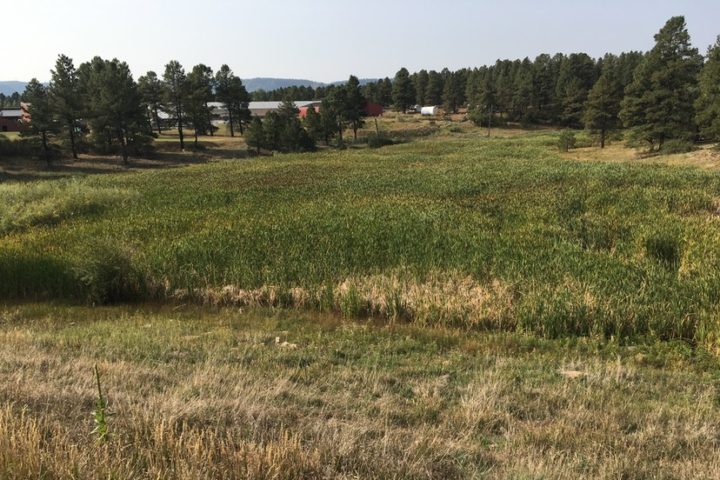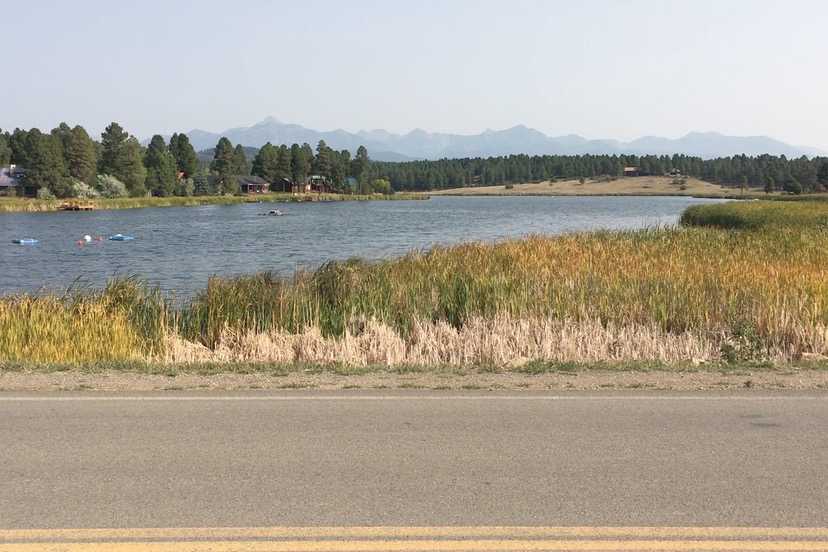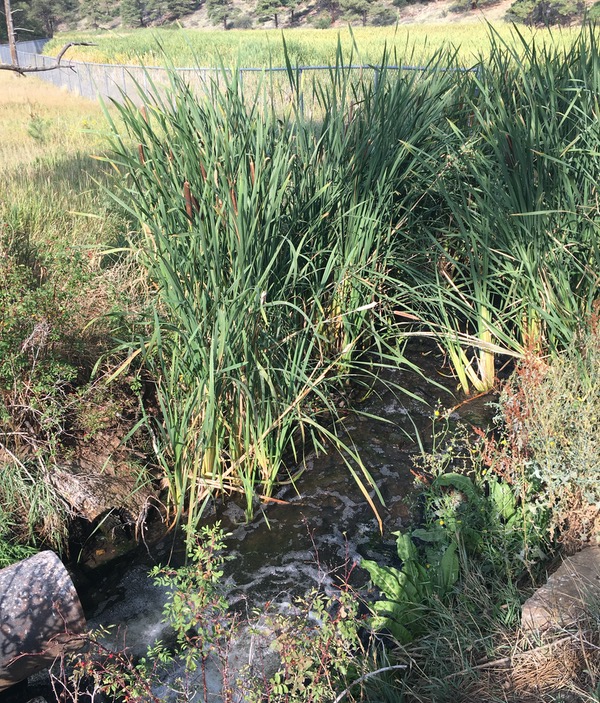PHOTO ABOVE: Lake Forest, also known as Borns Lake Reservoir, and the suburban neighborhood just north of the Vista Waste Water Treatment Plant.
As mentioned previously, the Vista Waste Water Treatment Plant (Vista WWTP), built about 15 years ago across the street from Lake Forest, pours about one million gallons of treated sewer effluent per day into the Borns Draw — water that was flushed down the drains of the majority of our community’s homes and businesses. The surrounding suburban neighborhoods have, in the past, occasionally fielded odor complaints, and when I took a tour of the plant last month with District Manager Justin Ramsey, I could definitely tell I wasn’t walking through a pine forest.
I didn’t notice the odor, however, when we reached the north edge of the facility, where the treated water flows out into a massive wetlands.


The outflow increased substantially a few years ago Pagosa Area Water and Sanitation District (PAWSD) and the Pagosa Springs Sanitation General Improvement District (PSSGID) collaborated on a rather expensive pipeline that now delivers sewage from downtown Pagosa, seven miles uphill, to the Vista plant.
And that increase may have been the trigger that caused the Colorado Department of Public Health and Environment (CDPHE) to place a new requirement on PAWSD, to start meeting water quality Regulation 85. Or maybe it wasn’t.
Maybe Colorado has simply become more serious about nitrogen in the water, no matter where it comes from.
As mentioned earlier in this editorial series, humans are dependent upon plants, and upon animals that eat plants, for our survival. And plants are dependent upon nitrogen — among other things — to build the proteins they need. But most of the world’s vegetation is able to find enough nitrogen in the natural environment without human intervention. Microbes living in the soil pull nitrogen gas from the air and convert it into nitrogen compounds that plants can utilize.
But 10,000 years ago — give or take a millennium or two — humans began developing the art of agriculture, and started finding ways to increase the fertility of the soil, artificially. Many of those techniques are still in use today, among farmers who grow organically. But most of the world’s farmers now grow their crops ‘industrially’ — by applying synthetic fertilizers that increase crop yields (and profits).
Industrial agriculture has greatly reduced the number of people needed to grow the world’s food supply, and that has led to a number of important changes. For one thing, many people now have nothing to occupy them, other than Facebook and online news.
Another result of industrial farming are ‘dead zones.’
Here’s a short video about the dead zone in the Gulf of Mexico.
We’ve known, for a long time, about the problem of synthetic fertilizers carelessly spread over America’s farmlands. When nitrogen and phosphorus are over-applied — applied in amounts larger than what the crops can absorb — the excess nitrogen and phosphorus eventually makes its way into the nearest surface waters, and joins the water’s journey into a lake or perhaps all the way to the ocean.
The excess nutrients cause deadly algal blooms in lakes, and ‘dead zones’ in the world’s oceans.
As PAWSD District Manager Justin Ramsey and I stood looking out at the cattails that are fed and watered by the effluent from the Vista WWTP, last month, we weren’t talking about algal blooms or dead zones.
Quite the opposite. We talked about whether the vegetation in Borns Draw was in fact absorbing the ‘excess’ inorganic nitrogen that was flowing across, and into, the ground. Were these plants capable of ‘purifying’ the WWTP effluent efficiently enough to satisfy Regulation 85?
And thus, able to save the PAWSD customers and taxpayers from building a $12 million addition to the treatment facility?
PAWSD didn’t yet have data to support this idea, and Mr. Ramsey was skeptical about whether CDPHE would accept a field of cattails as an alternative to a multi-million-dollar facility upgrade.
When I spoke with Mr. Ramsey this week, he let me know that PAWSD has in fact been tracking the nitrogen levels in the water, and comparing the amount of nitrogen as the effluent enters Borns Draw, with the levels as the water flows out at the western end of the draw. Things looked a bit hopeful at first, he told me, but more recently the numbers ‘going in’ and ‘coming out’ were showing very little difference. Which makes sense, of course. We are entering the winter season, and plants do not grow noticeably during the winter. So presumably, they would not be absorbing as much nitrogen during their dormancy.
So it looks very likely that we’ll be funding a plant upgrade, in the near future.
Unless, of course, we choose instead to make a new law requiring people to pee out in the back yard, instead of flushing the ammonia-rich urine down the toilet.



